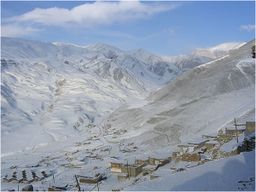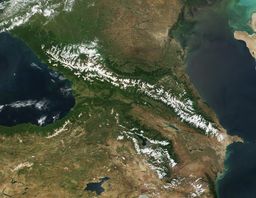جبال القوقاز
| جبال القوقاز | |
| سلسلة جبال | |
| البلدان | روسيا الجنوبية (داغستان، چچنيا، قبردينو - بلقاريا، قرة چاي - چركسيا، اوستيا الشمالية - ألانيا إنگوشتيا) , جورجيا, أذربيجان, أرمنيا, شمال إيران، تركيا |
|---|---|
| أعلى نقطة | جبل البروس |
| - المنسوب | 5،642 m (18،510 ft) |
| - الإحداثيات | 43°21′18″N 42°26′31″E / 43.35500°N 42.44194°E |
| الطول | 1،100 km (684 mi) |
| الاتساع | 160 km (99 mi) |
صورة بالساتل
| |
جبال القوقاز هي سلسلة جبلية تقع في أوراسيا بين البحر الأسود وبحر قزوين في منطقة القوقاز.
تتكون جبال القوقاز من نظامي جبال منفصلين:
- سلسلة جبال القوقاز الكبرى
- جبال القوقاز الصغرى.
سلسلة جبال القوقاز الكبرى تمتد من المحمية الطبيعية القوقازية بالقرب من سوتشي على الساحل الشمالي الشرقي للبحر الأسود، ويمتد عموماً باتجاه الشرق-جنوب شرق ويصل تقريباً إلى باكو على بحر قزوين، بينما القوقاز الأصغر يجري موازياً للسلسلة الكبرى، على بعد يقرب من 100 كم (60 ميل) إلى الجنوب. سلسلة جبال مسختي هي جزء من جبال القوقاز الصغرى. سلسلتا جبال القوقاز الأكبر والأصغر تربطهما سلسلة جبال ليخي، التي تفصل منخفضات قولخيدا عن منخفضات كورا-أراس. وفي الجنوب الشرقي توجد جبال طاليش. وتشكل القوقاز الأصغر والمرتفعات الأرمنية المرتفعات عبر القوقازية. أعلى قمة في سلسلة القوقاز هي جبل إلبروس في القوقاز الأكبر، الذي يصل ارتفاعه إلى 5,642 متراً فوق سطح البحر. وستستضيف الجبال المحيطة بسوتشي الألعاب الاولمپية الشتوية 2014.
جبال القوقاز تمتد في روسيا وجورجيا وأذربيجان، وترتفع بين بحر قزوين والبحر الأسود، وتمتد من الشمال الغربي إلى الجنوب الشرقي حوالي 1,210كم، ويبلغ ارتفاع أعلى قمة فيها (جبل إلبروس) حوالي 5,642م فوق مستوى سطح البحر، وهي تُعدّ أعلى قمة في أوروبا. يعتبر العديد من الجغرافيين القوقاز خط الحدود الفاصل بين أوروبا وآسيا.
يتخلل هذه الجبال العديد من الممرات ويبلغ ارتفاعها أكثر من 3,000م. ويمر عبرها القليل من الطرق، بينما تلتقي خطوط السكك الحديد حول الجبال. وتنافس مثالج القوقاز مثيلتها في جبال الألب، إلا أنه لا توجد بها بحيرات تقريبا. تشمل الموارد المعدنية الغنية في القوقاز حقول النفط في باكو، وغروزني، ومياكوب، وخامات المنجنيز الغنية في جورجيا واحتياطيات خام التنجستن والموليبدنوم الثمين.
تبرز أهمية القوقاز التاريخية في أنها كانت حاجزًا للهجرات، إلا أن العديد من الغزوات قد تخطتها في العصور القديمة والوسطى.
التكوين الچيولوچي
The Caucasus Mountains (روسية: Кавказские горы بالجورجية: კავკასიონი بالأرمينية: Կովկաս آذربيجاني: Qafqaz) formed largely as the result of a tectonic plate collision between the Arabian plate moving northward with respect to the Eurasian plate. The entire region is regularly subjected to strong earthquakes from this activity. The Lesser Caucasus Mountains on the other hand, are largely of volcanic origin. The Javakheti Volcanic Plateau in Georgia and the surrounding volcanic ranges which extend well into central Armenia are some of the youngest features of the region.
وتوجد احتياطات هيدروكربون كبيرة في المنطقة، وخصوصاً بالقرب من بحر قزوين.
الإنتماء الجغرافي
There is no clear agreement on whether the Caucasus Mountains are a part of Europe or Asia. Thus Europe's highest mountain is either Mount Elbrus 5٬642 m (18٬510 ft), in the Caucasus Mountains, or Mont Blanc 4٬810 m (15٬781 ft), in the Alps at the Italian-French border, depending on which continent the Caucasus Mountains are assigned to.
The Caucasus Mountains are located in the middle of the Eurasian plate between Europe and Asia. The ancient Greeks saw the Bosphorus and the Caucasus Mountains as the border of Europe, while it has to be considered that Caucasus also referred to the Caucasus Indicus (modern day Hindu Kush). Later this concept changed several times for political reasons. In the Migration Period and the Middle Ages, Bosphorus and the river Don divided the two continents.
The border was defined by the Swedish military officer and geographer Philip Johan von Strahlenberg, who suggested the border follow the peaks of the Urals, and then the lower Emba and the coast of the Caspian Sea, before passing through the Kuma-Manych Depression, which lies 300 km north of the Caucasus Mountains. In 1730, this course was approved by the Russian Tsar and since then was adopted by many scientists. Following this definition, the mountains are a part of Asia and according to this view, the highest European mountain is Mont Blanc.
On the other hand, La Grande Encyclopédie clearly draws the border between Europe and Asia south of both Caucasian mountain ranges.[بحاجة لمصدر] Both Elbrus and Kazbek are European mountains by this definition.
قائمة أعلى القمم
يسرد الجدول أدناه بعض أعلى القمم في القوقاز. With the exception of شخارا, the heights are taken from Soviet 1:50,000 mapping. There are higher and more prominent, but nameless, peaks than some of the peaks included below.
| اسم القمة | الارتفاع (م) | البروز (م) | البلد |
|---|---|---|---|
| إلبروس | 5,641 | 4,741 | روسيا |
| ديخ-تاو | 5,205 | 2,002 | روسيا |
| شخارا | 5,201 | 1,365 | روسيا/جورجيا |
| كوشتان-تاو | 5,152 | 822 | روسيا |
| جانگا (جانگي-تاو) | 5,059 | 300 | روسيا/جورجيا |
| كزبك | 5,047 | 2,353 | روسيا/جورجيا |
| پوشكين | 5,033 | 110 | روسيا/جورجيا |
| كاتين-تاو | 4,979 | 240 | روسيا/جورجيا |
| شوتا روستاڤلي | 4,860 | c.50 | روسيا/جورجيا |
| تتنولد | 4,858 | 672 | جورجيا |
انظر أيضاً: قائمة أكثر الجبال بروزاً في القوقاز
المناخ
The climate of the Caucasus varies both vertically (according to elevation) and horizontally (by latitude and location). Temperature generally decreases as elevation rises. Average annual temperature في سوخومي، أبخازيا عند سطح البحر تكون 15 درجة سلسيوس، بينما على سفوح جبل كزبك على ارتفاع 3700 متر، فالمتوسط السنوي لدرجة الحرارة ينخفض إلى -6.1 درجة سلسيوس. The northern slopes of the Greater Caucasus Mountain Range are 3 degrees (Celsius) colder than the southern slopes. تتمير مرتفعات جبال القوقاز الصغرى في أرمنيا، أذربيجان، وجورجيا بتناقض حاد في درجات الحرارة بين شهور الصيف والشتاء بسبب مناخ أكثر قارية.

Precipitation increases from east to west in most areas. Elevation plays an important role in the Caucasus and mountains generally receive higher amounts of precipitation than low-lying areas. المناطق الشمال شرقية (داغستان) والأجزاء الجنوبية من جبال القوقاز الصغرى هي الأجف. The absolute minimum annual precipitation is 250mm (8.4 inches) in the northeastern منخفض القزوين. Western parts of the Caucasus Mountains are marked by high amounts of precipitation. The southern slopes of the Greater Caucasus Mountain Range receive higher amounts of precipitation than the northern slopes. Annual precipitation in the Western Caucasus ranges from 1000-4000mm (39-157 inches) while in the Eastern and Northern Caucasus (چچنيا، إنگوشتيا، قبردينو-بلقاريا، اوستيا، كاختي، كارتلي، إلخ.) precipitation ranges from 600-1800mm (23.6-70.9 inches). The absolute maximum annual precipitation is 4100mm (161 inches) around the Mt. Mtirala area which lies on the سلسلة جبال مسختي في أجاريا. The precipitation of the Lesser Caucasus Mountain Range (جورجيا الجنوبية، أرمنيا، أذربيجان الغربية)، ولا تضم سلسلة جبال مسختي، تتراوح من 300-800 مم سنوياً.
The Caucasus Mountains are known for the high amount of snowfall, although many regions which are not located along the windward slopes do not receive nearly as much snow. This is especially true for the Lesser Caucasus Mountains which are somewhat isolated from the moist influences coming in from the البحر الأسود and receive considerably less precipitation (in the form of snow) than the Greater Caucasus Mountains. The average winter snow cover of the Lesser Caucasus Mountains ranges from 10-30cm (4-12 inches). The Greater Caucasus Mountains (especially the southwestern slopes) are marked by heavy snowfall. Avalanches are common from November-April.
وقد يصل الغطاء الثلجي في عدة مناطق (سڤانتيا، أبخازيا الشمالية) 5 أمتار. أما منطقة جبل أچيشخو، التي هي المكان الأغزر ثلجاً في القوقاز، فكثيراً ما يسجل أعماقاً للجليد تتجاوز 7 أمتار.
الطبيعة
The Caucasus Mountains have a varied landscape which mainly changes vertically and according to the distance from large bodies of water. The region contains biomes ranging from subtropical low-land marshes/forests to glaciers (Western and Central Caucasus) as well as highland semideserts/السهوب وalpine meadows in the south (أساساً في أرمنيا وأذربيجان).
السفوح الشمالية لجبال القوقاز العظمى يغطيها البلوط، hornbeam، القيقب، and ash forests at lower elevations while birch and pine forests take over at higher elevations. Some of the lowest locations/slopes of the region are covered by السهوب وgrasslands. سفوح شمال غرب جبال القوقاز العظمى (قبردينو-بلقاريا، چركسيا، إلخ.) تضم أيضاً غابات spruce وfir. تحل المنطقة الجبلية محل الغابة عند ارتفاع 2,000 متر فوق سطح البحر. The permafrost/glacier line generally starts around 2,800-3,000 meters. The south-eastern slopes of the Greater Caucasus Mountains are covered by beech, oak, maple, hornbeam, and ash forests. Beech forests tend to dominate in higher locations. The south-western slopes of the Greater Caucasus are covered by Colchian forests (oak, buxus, beech, chestnut, hornbeam, elm) at lower elevations with coniferous and mixed forests (spruce, fir and beech) taking over at higher elevations. The alpine zone on the southern slopes may extend up to 2,800 meters above sea level while the glacier/snow line starts from 3,000-3,500 meters.
تتميز السفوح الشمالية والغربية لجبال القوقاز الصغرى بكل من Colchian and other deciduous forests at lower elevations while mixed and coniferous forests (mainly spruce and fir) dominate at higher elevations. Beech forests are also common at higher elevations. السفوح الجنوبية لجبال القوقاز الصغرى يغطي معظمهما grasslands and steppes up to an elevation of 2,500 meters. The highest areas of the region contain alpine grasslands as well. Volcanic and other rock formations are common throughout the region. المنطقة البركانية تمتد فوق مساحة كبيرة من جورجيا الجنوبية إلى أرمنيا وجنوب غرب أذربيجان. بعض القمم البارزة في المنطثة تضم جبل أرگاتس، ديدي أبولي، سمساري، وغيرهم. تتميز المنطقة بهضاب بركانية، lava flows, بحيرات بركانية، أقماع بركانية وسمات أخرى. وتفتقد جبال القوقاز الصغرى إلى نوع المثلجات/السمات الجليدية الشائعة في سلسلة جبال القوقاز العظمى.
أجزاء من هذه المقالة من مرصد الأرض لناسا؛ [1]
مراجع
انظر أيضاً
- Small Nations and Great Powers: A Study of Ethnopolitical Conflict in the Caucasus By Svante E. Cornell
روابط خارجية
- NASA Earth Observatory images of the Caucasus: [2]
- Highest Peaks of the Caucasus from peakbagger.com
- Pages using gadget WikiMiniAtlas
- Pages using geobox2 unit with unknown unit type
- صفحات المعرفة التي فيها البلد أو التقسيم غير معروف
- Pages using deprecated coordinates format
- Geobox usage tracking for other type
- Articles containing روسية-language text
- Pages using Lang-xx templates
- Articles containing جورجية-language text
- Articles containing أرمنية-language text
- Articles containing آذربيجاني-language text
- مقالات ذات عبارات بحاجة لمصادر
- Coordinates on Wikidata
- القوقاز
- سلاسل جبال آسيا
- سلاسل جبال اوروبا
- سلاسل جبال روسيا
- سلاسل جبال أذربيجان
- سلاسل جبال جورجيا
- سلاسل جبال إيران
- أقاليم فيزيوغرافية




